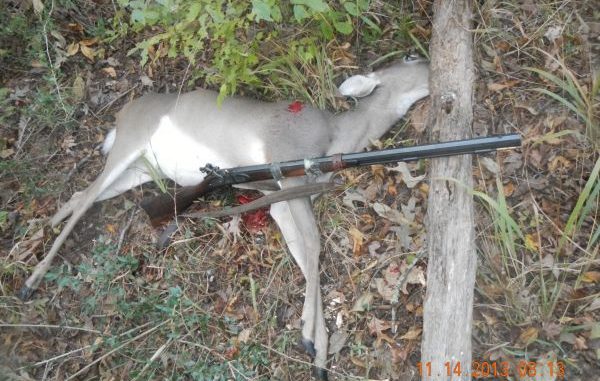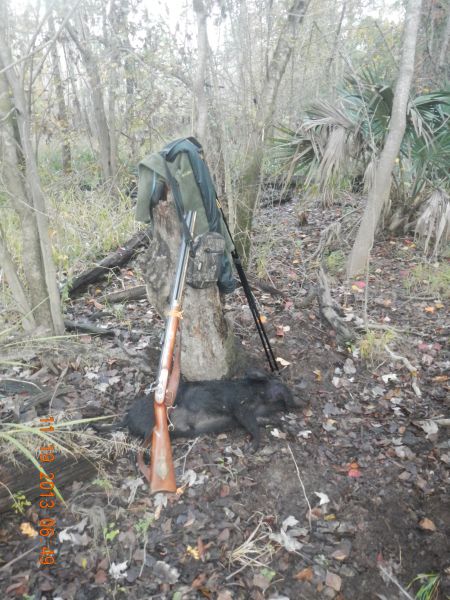
A new year brings new challenges, but there is still a month left of deer hunting if you have not killed a deer yet.
In the December issue I asked if you had killed a deer in November. Well, November is still not over as I write the January column and I have to say it has been a great month for me. Generally I kill my first deer of the season in December. Like October the month of November can be a slow month; the weather that is always a factor impacting deer movement can be warm and mild, but this year we were blessed with some cold fronts.
During the first week of November I traveled to North Louisiana to hunt with my friends Larry Savage in Union Parish and Ken Mason in Bossier Parish. I brought my new Remington 783 (.30-06) that I had won at the Louisiana Outdoor Writers Association Conference. It shoots a tight group, and I was blessed to bag a pig and a doe with it, both at 150 yards.
It appeared that reproduction was excellent in both these parishes, and hopefully the deer have recovered from the drought years of 2010 and 2011.
It appeared to me that the rut was on a little earlier than normal, but just as was predicted.
The Area 4 muzzleloader season opened on one of those unwelcome warm days, and the activity was slow. I did see a doe fawn and a couple of runty 1 ½-year-old spikes, but the morning warmed up quickly and I had to be in early to watch LSU get hammered by Alabama.
However, conditions changed on Tuesday evening, so I eased up to Camp David in Clinton. Another full-moon period was approaching, and Tuesday evening the moon was so bright that about 8 p.m. I had to go sit in the stand and see if any pigs would show up. The moon was directly overhead, and it wasn’t long before I saw movement. A deer moved in to the bait site.
If you adhere to the theory that deer feed when the moon is directly overhead, then this was proof that it is true. I was a little concerned that if deer are doing this now everywhere, the morning hunt might not be so good.
The next morning I was on a hardwood ridge looking over a drain; the temperature was around 30, the barometric pressure was 30 plus — ideal conditions for deer movement.
I was not disappointed. I saw two small spikes, a nice spike, a pseudo 4-pointer and three does, but I took no shots. I was hunting with my .54 Great Plains long rifle.

For the evening hunt, I moved to a green patch that does have a white oak tree in it that was dropping some acorns. A small group of turkeys came out around 4 p.m., and I was pleased to see that four of them were jakes. So our hatch appears better than what I had thought.
Around 5 p.m. I saw movement on the edge of the patch and out walked an adult 5-pointer that proceeded to work scrapes. The buck pawed the ground at several spots, worked the overhead branches with its small rack and rubbed its eye gland on some limbs.
I decide this low-end buck should be harvested; it is one that I had photos of and that was hanging out with one of the larger bucks.
I was hunting with my .444 that generally does not miss, but when I pulled the trigger the buck just stood there rubbing its head in the bushes. I knew immediately when the hammer clicked that I had not put a cartridge in the chamber.
As I cracked the single-shot open I began to wonder if I had even put bullets in my pocket, but I had. So with the rifle now loaded I aimed again, fired and the buck fell at the edge of the patch.
This buck was a solid 3 ½-year-old, and the live weight was 140 pounds; the 2×3 rack wasn’t much, about 8 inches on the inside.
This was one of those small spikes I had watched earlier that was now an adult buck. This is what I am constantly preaching: Low-end young deer on mediocre habitat turn out to be low-end adult deer. In our forest that is dominated with pine plantation and has no row crop agriculture — just cattle pastures — these young deer do not catch up and become the deer we want because the nutrition is simply not there for the desired growth and development.
A 1 ½-year-old buck that weighs 100 pounds might achieve a 20-percent increase in body weight and will weigh 120 at 2 ½ years of age. This buck at 3 ½ increased another 20 percent and weighed 140, which is exactly the type of deer I shot.
Either shoot them when they are runts at 1 ½ or let them eat on the habitat for a few years and shoot them when they are adults. You do get a little more meat if you wait.
Unfortunately, what often happens is that hunters see these low-end adult bucks and think they are young deer and will get better, but they never do. There is no steak and potato food in the woods for these deer to get better.
The desired increase in growth would be 30 to 40 percent. What would be even better is for that 1 ½-year-old buck to weigh 125 or more. A buck weighing this much and that gets a 30-percent increase in body weight is a 160 pound deer; now you are producing something that is capable of growing a good set of antlers.
Again the rut appeared to be starting in Area 4, earlier than normal, but just as predicted. It will be interesting to look at some pregnant deer in the late season and see if the breeding was, indeed, early.
The next morning I was back to the hardwood ridge with the long rifle and when a doe presented the shot, I aimed, fired and the doe dropped in its tracks. I shoot 100 grains of black powder with a patched round ball; I have killed most of my largest bucks with this rifle, and it still shoots well. Simply a matter of keeping the powder dry.
The next few days the weather changed, with warm coastal temperatures moving in and shutting down deer movement. My son and son-in-law hunted the two days following my doe harvest and saw zero deer. Weather is so important to hunting success in the Bayou State.
The next week I visited the Pearl River WMA with my buddy McElroy for that primitive season. On this hunt I was using my Isaac Rifle, a 50-caliber T/C that shoots 80 grains of powder and a 370-grain maxi-bullet. I had killed a doe with it last year and wanted to connect with a pig or buck.
We hunted the areas where we had squirrel hunted in October, and I got into action right after daylight. I heard pigs in the woods across a slough from me and I began to cross the slough; I could see some grass moving, and was certain it was a pig rooting around.
All of a sudden the pigs that had been squealing and grunting came running in, chasing and fighting with one another. I was standing in the slough waiting and finally had a shot; a pig hit the ground and started this horrendous squealing while I was fumbling around trying to reload and not drop anything in the water.
Finally I put the cap on the nipple and finished crossing the slough. It is a dangerous thing for an old man with bad knees wearing hip boots to cross a wide slough. I had hit the pig in the top of the back through the spine, and all it could do was lift its head and try to get up; another shot through the head finished it off.
I hunted a few more hours and saw lots of good sign but no live critters. The acorns were being eaten up as fast as they hit the ground, and there were acorns still in the trees, so we were going back for the Thanksgiving hunts.
As I said I am writing this with still two more full months of deer hunting left. Some very good bucks have been killed to date, as the front cover of this magazine clearly shows. If these cold fronts continue I suspect it might turn out to be an excellent deer season.
Happy New Year everyone, and for those of you whose deer season has ended, take heart, a new year has begun and in eight months the 2014 season will begin.


